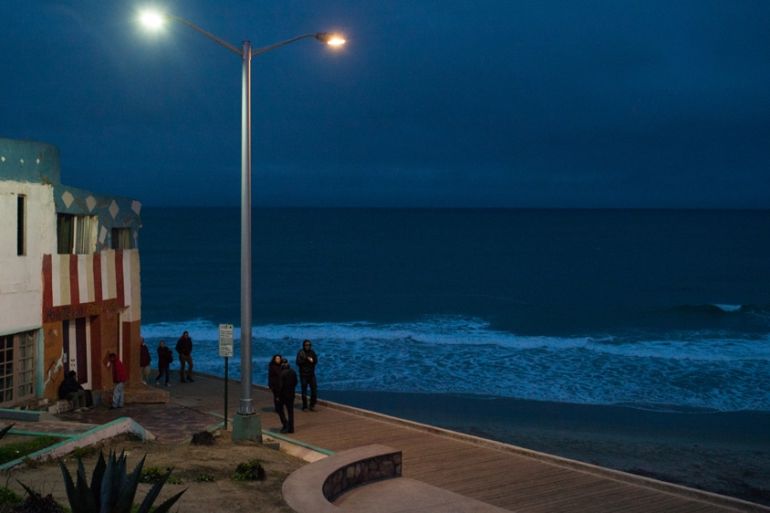Donald Trump’s Wall: The human factor
Uncertainty over the future abounds for many on either side of the border including migrants and local business owners

San Diego, United States – It’s hard to find a supporter of President Donald Trump in this area – questions posed to bystanders near the US side of the border elicit laughs and expressions of disdain for Trump among those who voted in the presidential election – both Mexican and non-Mexican Americans.
Still, one hears stories of Mexican Americans who do support Trump and hope that the wall will stop undocumented migrants from entering the country.
![As President Trump seeks to tighten borders, more and more migrants hoping to reach the US have found themselves blocked at the border [Jessica Chou/Al Jazeera]](/wp-content/uploads/2017/03/ca0db9bd208f429193b26ec05bdfa021_19.jpeg)
At an outlet mall near the border, one young Trump voter declines to go on the record.
Keep reading
list of 4 itemsTrump’s defence makes opening statement in ‘hush money’ trial
Man sets himself on fire outside of Trump’s New York hush-money trial
Full jury panel seated on third day of Trump’s New York hush-money trial
Another young man says that he has relatives who voted for Trump, but declines to go on the record about them or to introduce them to Al Jazeera. That young man’s friend directs Al Jazeera to the well-to-do Eastlake neighbourhood of San Diego, where Trump supporters might be found. In Eastlake, there are walled communities. The houses are a far cry from the modest homes closer to the border.
“I don’t have a problem with [the wall] and I’m Hispanic,” says Kelly Zuniga, 27, a Mexican-American born in San Diego. “He does,” she says, referring to her boyfriend, Andrew Vasquez, also 27.
Part of Kelly’s stance on the wall is that she doesn’t think it will change much.
“It’s not going to stop anything,” she says. “They are still going to cross anyway. It doesn’t make a difference.” She has “nothing against Donald Trump,” she adds.
“Maybe it’ll be better for the country,” Vasquez reflects.
Vasquez has a brother who is “a firm supporter” of Trump. “I don’t know. They just believe his business concept,” he explains.
About the wall, Vasquez suggests that his brother is “thinking about his kids. There is terrorism in this world. It’s real.”
“He’s not doing it to be racist, he’s just trying to make it better for us,” Zuniga says.
“He’s trying to make a better America in his point of view,” Vasquez adds.
![The US-Mexico wall as seen from Playas de Tijuana in Mexico [Jessica Chou/Al Jazeera]](/wp-content/uploads/2017/03/b6ceff107576490d826fd026e22566e2_18.jpeg)
Crossing over
Uncertainty over the future abounds for many on both sides of the border – and for all involved: the migrants, the smugglers, the shelters, the environmentalists, the business owners.
At night, a time when websites that measure traffic at the border indicate that hours-long queues are common, there is no wait to pass into the United States . Very few cars are lined up for what in previous years was a constant flow of people coming and going.
Border patrol officers make playful jokes with people crossing the border that, once they arrive on the other side, those crossing complain caused anxiety.
The implication in even lighthearted, less-than-professional behaviour from border patrol is that there isn’t much oversight to what officers do here. The laws governing these officers allow them to prohibit the use of phones and photography to document what they do, particularly when people are detained in “secondary” – the border holding facility.
![A Customs and Border Patrol officer patrols the US side of the border with Mexico [Jessica Chou/Al Jazeera]](/wp-content/uploads/2017/02/e174fbdbeda34f2192b3e3be3fe4c33f_18.jpeg)
Susan Smith moves frequently across this border – like many people who live in border cities – to see family or for work and school.
Trump ‘s plans may scare some away from the border, but she will continue to visit her daughter and grandson in San Diego, she says. For her, the wall – not yet designed – will be more of an abstraction than a barrier.
She cites recent calls by the San Diego and Tijuana mayors to not let Trump’s foray from the business world into international diplomacy affect longer-standing cross-border, regional ties.
“The metaphor of the build the wall [is meant to say, let’s] save ourselves from the people of colour. [It’s about] the hate and fear mongering of immigrants, Muslims, LGBT peoples and any and everyone who is now on the enemies list. It is a big bone thrown out to hungry, ravenous and rabid dogs of war,” she says.
In what is perhaps a sign of the differences on either side of the border wall, Smith observes that Mexican senators were engaged in a push to create what they call a “human wall, bridge of nations” that took place on February 17 at the border, according to Mexican media reports.
The objective of the demonstration was to show solidarity with people across the existing and pending barriers.
![A number of migrant shelters can be found in Zona Norte, known as the red light district of Tijuana and a hotbed for criminal and gang activity [Jessica Chou/Al Jazeera]](/wp-content/uploads/2017/03/38fecef484534375878d2dfb71f58121_18.jpeg)
This is the fourth story in a five-part series looking at the US-Mexico wall and the people who live alongside it. If you want to follow this story, please enter your email here